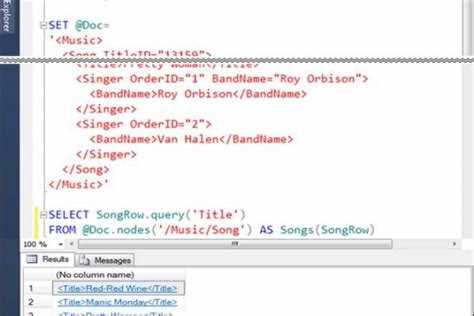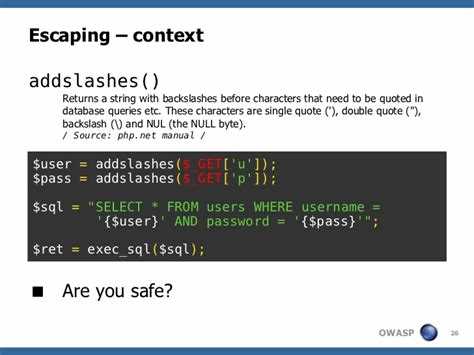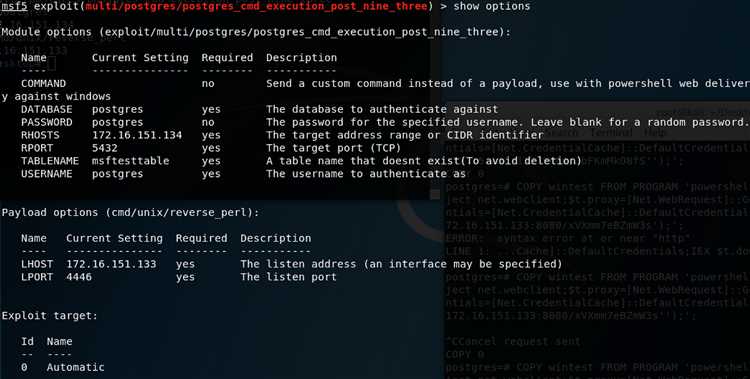SQL (Structured Query Language) is one of the most widely used programming languages for managing and manipulating databases. However, when working with SQL, you may come across a common problem – how to escape single quotes in SQL queries. Single quotes are used to delimit string values in SQL, so if a string value contains a single quote, it can cause the query to fail or lead to unexpected results.
Fortunately, there are several methods you can use to escape single quotes in SQL. One common approach is to use double single quotes (”). In SQL, two consecutive single quotes are treated as a single quote character. For example, if you want to insert the string “John’s book” into a table, you can write it as “John”s book”. This tells the database to treat the two single quotes as a single quote within the string.
Another method for escaping single quotes in SQL is to use the backslash (\) character. In many SQL dialects, including MySQL and PostgreSQL, the backslash is used as an escape character. To escape a single quote, you can precede it with a backslash. For example, “John\’s book”. This tells the database to interpret the single quote as part of the string, rather than as a delimiter.
In addition to using double single quotes or the backslash character, some SQL dialects provide built-in functions for escaping special characters, including single quotes. For example, in MySQL, you can use the function mysql_real_escape_string() to automatically escape single quotes in a string. This function adds backslashes before every occurrence of a single quote character, ensuring that the string is treated correctly.
Escaping single quotes in SQL is an important skill for any developer working with databases. By understanding and applying the various methods for escaping single quotes, you can avoid common errors and ensure the correctness and security of your SQL queries.
What is SQL
SQL, short for Structured Query Language, is a programming language used for managing and manipulating relational databases. It provides a standardized way to interact with the databases and perform various operations such as creating, modifying, and retrieving data.
SQL is not a general-purpose programming language like Java or Python, but rather a domain-specific language specifically designed for working with databases. It is commonly used by developers, data analysts, and database administrators to interact with database systems efficiently and effectively.
Key Features of SQL:
- Database Schema Definition: SQL provides a way to define the structure of a database including tables, columns, and relationships between tables.
- Data Manipulation: SQL allows you to insert, update, delete, and retrieve data from a database.
- Querying: SQL provides a powerful querying mechanism to filter, aggregate, and transform data stored in the database.
- Indexing: SQL allows you to create indexes on columns to improve the performance of queries.
- Transactions: SQL supports atomic transactions that ensure multiple database operations are treated as a single unit of work.
- Security: SQL includes features for granting and revoking permissions, ensuring data security.
SQL is a standard language that is supported by many database management systems (DBMS), including popular ones like MySQL, PostgreSQL, Oracle, Microsoft SQL Server, and SQLite. Although different DBMS may have their own specific variations and extensions, the core SQL syntax and concepts remain largely consistent across different implementations.
Overall, SQL is a vital tool for working with relational databases, providing a powerful and efficient way to manage and manipulate data. Understanding SQL is essential for anyone working with databases and seeking to build robust and efficient applications.
Importance of Escaping Single Quotes
In SQL, escaping single quotes is crucial to ensure the integrity and reliability of your database operations. Single quotes are commonly used to delimit string literals in SQL queries. However, if a user-supplied value contains a single quote character, it can lead to syntax errors or even worse, SQL injection attacks.
Single quote escaping is especially important when dealing with user input that is incorporated into SQL queries. Without proper escaping, an unintended single quote can terminate the string literal prematurely, causing a syntax error. For example:
SELECT * FROM customers WHERE name = 'John O'Brien';
In the above query, if the user input for the name field is “John O’Brien”, the query will break because the single quote in O’Brien will be interpreted as the end of the string literal, resulting in a syntax error. By properly escaping the single quote, the query can be executed without any issues.
Escaping single quotes also helps protect against SQL injection attacks. An attacker can exploit unescaped single quotes to manipulate the structure of the query and perform unauthorized actions. For example:
SELECT * FROM users WHERE username = 'admin' OR '1'='1';
In this query, the attacker used the single quote to prematurely terminate the string literal and added a condition that will always evaluate to true. This could potentially retrieve sensitive information or modify data in the database.
By escaping single quotes, you effectively neutralize the risk of SQL injection attacks and ensure that the queries execute as intended. It is a best practice to always escape any user-supplied input that is incorporated into SQL queries to prevent these security vulnerabilities.
In conclusion, escaping single quotes is essential in SQL to maintain the integrity of your database operations and protect against SQL injection attacks. Always remember to properly escape single quotes when incorporating user input into SQL queries to avoid syntax errors and security vulnerabilities.
Common Methods to Escape Single Quotes
When working with SQL statements, it is important to properly escape single quotes to avoid syntax errors or SQL injection vulnerabilities. Here are some common methods to escape single quotes in SQL:
- Double the single quote: One of the most common methods to escape a single quote is to simply double it. For example, to escape the single quote in the word “can’t”, you can write it as “can”t”. This method is supported by most database systems.
- Use the backslash: Another method is to use the backslash ‘\’ as an escape character. For example, to escape the single quote in the word “can’t”, you can write it as “can\’t”. This method is also widely supported.
- Use the CHAR function: Some database systems provide a CHAR function that can be used to escape special characters. For example, to escape the single quote in the word “can’t”, you can write it as “can” || CHAR(39) || “t”. The number 39 represents the ASCII value of the single quote.
- Use parameterized queries: Parameterized queries or prepared statements are an effective way to escape single quotes and prevent SQL injection attacks. Instead of directly embedding user input into the SQL statement, you can use placeholders and bind variables to pass the values safely. This method is highly recommended for security purposes.
It is important to note that the method of escaping single quotes may vary depending on the database system you are using. It is always a good practice to refer to the documentation of your specific database system for the recommended method of escaping single quotes.
Using Double Quotes to Escape Single Quotes
In SQL, single quotes are used to delimit string values. However, if you need to include a single quote within a string value, you need to escape it. One way to escape a single quote is to use double quotes.
To escape a single quote using double quotes, you can enclose the string value in double quotes and use two consecutive single quotes within the string to represent a single quote character.
Here’s an example:
SELECT "I''m escaping a single quote using double quotes."
This query will return:
| I’m escaping a single quote using double quotes. |
|---|
As you can see, by using double quotes to enclose the string value and two consecutive single quotes within the string, the single quote character is escaped and included within the string.
It’s important to note that the use of double quotes to escape single quotes can vary depending on the database management system you are using. Some database systems may require different syntax or may have different rules for escaping characters. Make sure to consult the documentation or guidelines specific to your database system for accurate information.
In addition to using double quotes to escape single quotes, there are other methods available, such as using backslashes or concatenation operators. The method you choose may depend on the specific requirements and syntax of your database system.
Overall, using double quotes to escape single quotes in SQL can be a useful technique when working with string values that may contain single quotes. It allows you to include single quotes within a string without causing syntax errors or other issues in your SQL queries.
Using Backslashes to Escape Single Quotes
In SQL, the backslash character (\) is often used to escape special characters, including single quotes, within strings. When a backslash is followed by a special character, it tells SQL to treat that character as a regular character instead of its special meaning. This is useful when you need to include single quotes within a string literal.
Here are a few examples of how you can use backslashes to escape single quotes:
- Example 1: To include a single quote within a string, you can use two backslashes followed by a single quote. For example:
'It\'s raining.'This will be interpreted as It’s raining. - Example 2: If you have multiple single quotes within a string, you can use backslashes in front of each single quote. For example:
'She said, \'I can\'t believe it!\''This will be interpreted as She said, ‘I can’t believe it!’ - Example 3: You can also use backslashes to escape single quotes within a query. For example:
SELECT * FROM customers WHERE name = 'O\'Connor'This will match rows where the name is O’Connor.
When using backslashes to escape single quotes in SQL, it’s important to note that different database management systems may have slightly different rules or conventions. It’s always a good idea to consult the documentation for your specific database system to ensure you are using the correct syntax.
Implementing Parameterized Queries to Avoid Single Quote Escaping
Performing SQL queries with user input can introduce the risk of SQL injection attacks if the input is not properly sanitized. One common problem when dealing with user input is the presence of single quotes, which can break the syntax of the SQL query and potentially lead to a security vulnerability.
To avoid the need for single quote escaping and reduce the risk of SQL injection attacks, it is recommended to implement parameterized queries. Parameterized queries separate the SQL code from the user input by using placeholders instead of directly concatenating the values into the query string. The actual values are then provided as parameters when executing the query.
Here is an example of how to implement parameterized queries in SQL using a hypothetical programming language:
- Create a prepared statement: The prepared statement is a template of the SQL query with placeholders instead of the actual values. For example: SELECT * FROM users WHERE username = ? AND password = ?
- Bind the values to the placeholders: Bind the values provided by the user to the placeholders in the prepared statement. Make sure to specify the correct data types for the values. For example, bind the username value as a string and the password value as a hashed password.
- Execute the prepared statement: Execute the prepared statement with the bound values. The database driver will handle the necessary escaping and parameterization behind the scenes.
By using parameterized queries, the database engine automatically handles any necessary escaping of special characters like single quotes. This eliminates the need to manually escape single quotes and significantly reduces the risk of SQL injection attacks.
Another advantage of parameterized queries is that they can improve the performance of your application. Since the prepared statement is compiled and cached by the database engine, subsequent executions with different parameter values can reuse the compiled statement, resulting in faster query execution.
Overall, implementing parameterized queries is a best practice for handling user input in SQL queries. It helps to prevent SQL injection attacks, improves security, and can enhance the performance of your application.
Examples of Escaping Single Quotes in SQL Statements
When working with SQL statements, it is common to encounter situations where single quotes need to be included as part of the data being manipulated. However, single quotes are also used to denote string literals in SQL, so it is necessary to escape them in order to avoid errors. Here are some examples of how to escape single quotes in SQL statements:
- Using double single quotes: One commonly used method to escape single quotes is to use double single quotes. For example, if we want to insert the string “John’s house” into a table, we can use the following SQL statement:
- Using backslashes: Another method is to use backslashes to escape the single quotes. For example, the same SQL statement as above can be written as:
- Using the CHAR function: In some database systems, the CHAR function can be used to escape single quotes. For example:
- Using prepared statements: If you are using a programming language to interact with the database, it is recommended to use prepared statements with parameter binding. Prepared statements automatically handle escaping of special characters, including single quotes. Here is an example using PHP:
| SQL Statement | Result |
|---|---|
| INSERT INTO tablename (columnname) VALUES (‘John”s house’); | John’s house |
| SQL Statement | Result |
|---|---|
| INSERT INTO tablename (columnname) VALUES (‘John\’s house’); | John’s house |
| SQL Statement | Result |
|---|---|
| INSERT INTO tablename (columnname) VALUES (CHAR(39) || ‘John’ || CHAR(39) || ‘s house’); | John’s house |
| PHP Code |
|---|
|
// Assuming a database connection has been established $stmt = $pdo->prepare(‘INSERT INTO tablename (columnname) VALUES (:value)’); $stmt->bindParam(‘:value’, “John’s house”); $stmt->execute(); |
By escaping single quotes properly, you can ensure that your SQL statements are executed correctly and avoid any potential errors or vulnerabilities.
Question and answer:
What is a single quote in SQL?
In SQL, a single quote is a special character used to enclose text values, such as strings, in SQL statements.
Why do I need to escape single quote in SQL?
You need to escape single quotes in SQL to prevent syntax errors and to ensure that the single quote is treated as a part of the text value, rather than a delimiter.
What is the syntax to escape a single quote in SQL?
To escape a single quote in SQL, you can use another single quote right before the single quote you want to escape. For example, to escape the single quote in the word “can’t”, you can write it as “can”t”.
Are there any other ways to escape single quotes in SQL?
Yes, you can also use the CONCAT function in SQL to escape single quotes. For example, you can write “can” + CHAR(39) + “t” to escape the single quote in the word “can’t”.
What happens if I don’t escape a single quote in SQL?
If you don’t escape a single quote in SQL, it will be treated as the end of the text value, which will result in a syntax error. For example, if you write “can’t” without escaping the single quote, it will cause a syntax error in your SQL statement.
Can I use double quotes instead of single quotes in SQL?
Yes, in SQL, you can use double quotes to enclose text values instead of single quotes. However, you still need to escape the double quotes if they are part of the text value.


